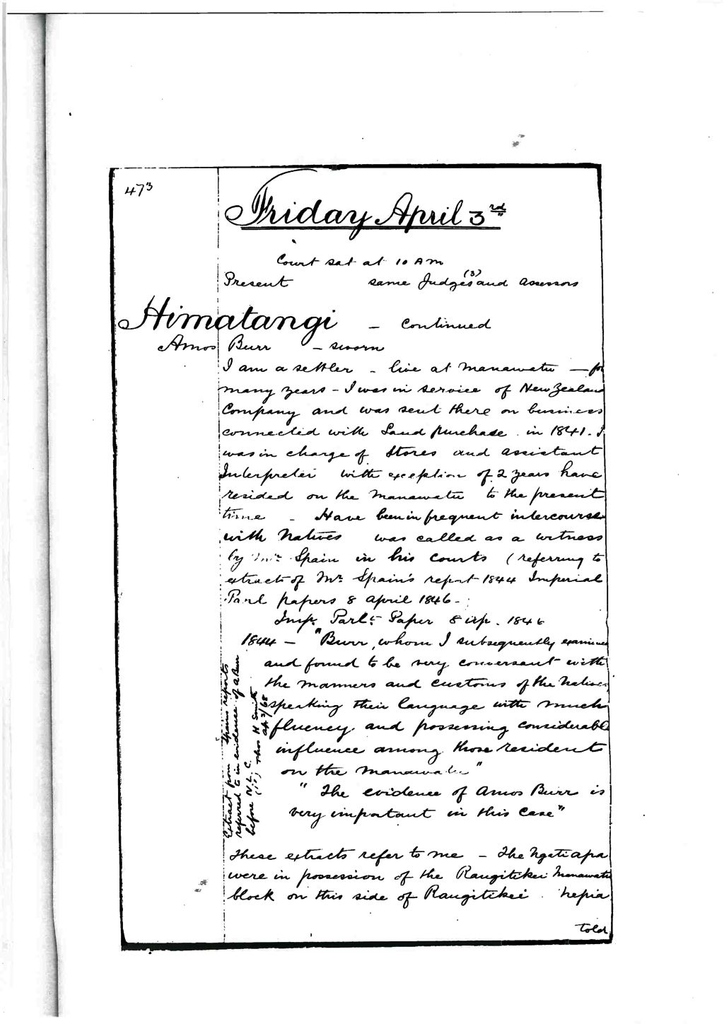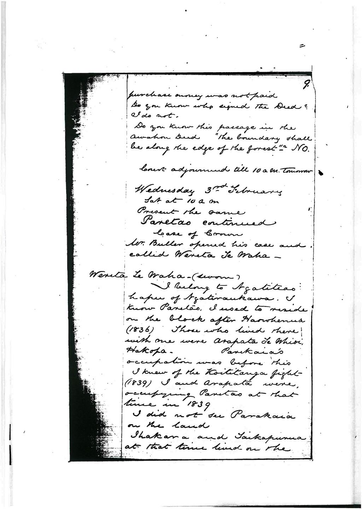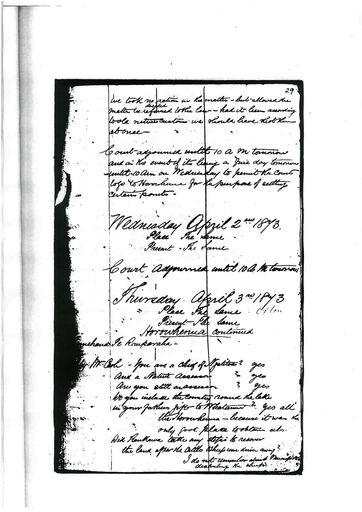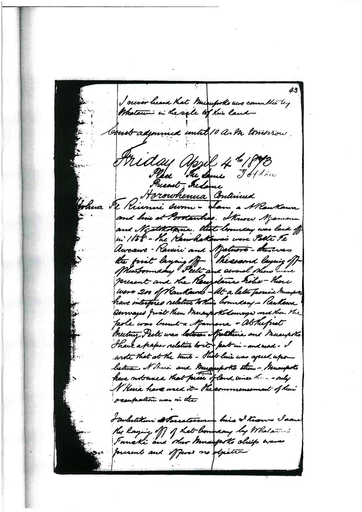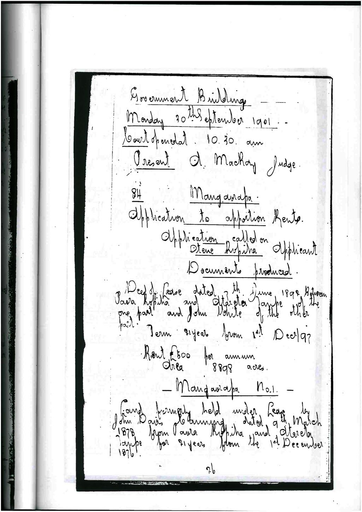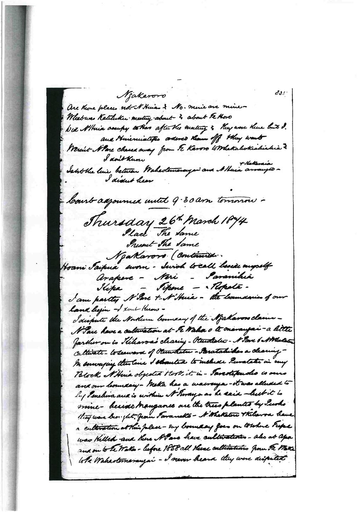3 April 1868
- Description
473-494
Friday April 3rd
Court sat at 10 am.
Present – same Judges (3) and assessors
Himatangi – continued
Amos Burr – sworn
I am a settler. Live at Manawatu for many years. I was in service of New Zealand company and was sent there on business connected with Land purchase in 1841. I was in charge of stores and assistant interpreter with exception of 2 years have resided on the Manawatu to the present time. Have been in frequent intercourse with natives. Was called as a witness by Mr. Spain in his courts (referring to extact of Mr. Spain’s report 1844 imperial parl papers 8 april 1846.
Imp. Parl. Paper 8 Ap. 1846
1844 – “Burr, whom I subsequently examined and found to be very conversant with the manners and customs of the natives, speaking their language with much fluency and possessing considerable influence among those resident on the Manawatu”.
The evidence of Amos Burr is very important in this case”.
These extracts refer to me.
The Ngatiapa were in possession of the Rangitikei Manawatu block on this side of Rangitikei. Nepia told me that their boundary came to Omarupapako 3 miles from Manawatu. Ngatiapa in possession of Rangitikei river – lower Manawatu in possession of Ngatiraukawa. Parewahawaha – Nepia’s people.
Wharanga, only fishing station, not a residence. Ngatiraukawa at Otaki. The Ngatiapa claimed and were in possession of country between Rangitikei and Manawatu especially at fishing places on the coast. It would not be time if any person were to say that Ngatiapa had no ‘mana’. It would not be true. Nepia distinctly told me that Ngatiapa were the original owners of the land and I always found what he said was true.
I should say it was not true that Ngatiapa were living in subjection to Ngatiraukawa.
I asked for a guide from here to take me to Whanganui. Ngatiraukawa said they were afraid of Ngatiapa and I had to go to Nepia about it. Ngatiapa were quite independent, equally with any other tribe on the coast. If any one were to say that Ngatiraukawa were in possession of all the country from Kukutanaki to Turakina, I whould say it was absurd.
I know Himatangi on Manawatu river. When I first went up there were no occupiers but there were old potato gardens there. I was up in 1845, but I speak more particularly of 1846. Knew the Ngati Upokoiri tribe. I heard them say that they were occupying jointly with Ngatiapa and Rangitane. Ngatirakau hapu of Ngatiraukawa occupied the river bank about a mile above Opiki. I understood from Taraotea that they had not been above Opiki but they went to Te Kirikiri to catch ‘upoko roro’ in the river.
I had instructions to make this enquiry for the N.Z. Coy.
I believe the Ngatirakau were not there before 1846. Ngati Te Upokoiri were a numerous and industrious tribe. They were the principal tribe occupying Manawatu. Ngatiraukawa did not occupy much until after the land had been sold to N.Z. Coy, when they made cultivation by permission.
I understood that Ngatiraukawa occupied Rangitikei by consent of owners, was told so by Nepia who lived on friendly terms with Hakeke. The natives gave me to understand that the reason why Ngatiapa retired northward and left the lands, we wished to purchase, was for religious objects to be near their missionary (Mr. Taylor). They were not driven away by Ngatiraukawa. I heard what I say from both parties.
I remember the meeting at Te Awahou on the occasion of sale of the Awahou block to Mr. McLean. Nepia Taratoa took a prominent part at that meeting. Nepia opposed the sale and finally consented only conditionally, that the rest of the land should be left to him and his people who were under his feet. He spoke to the principal chiefs of Ngatiraukawa. I and many others understood that he referred to Ngatiapa as his people ‘ana tangata’.
I remember the circumstance of Skipwith’s lease of Himatangi. Heard from natives and Mr. James Bell, who was Mr. Skipwith’s managing man.
Native’s account corresponded with Bell’s account. Understood from Bell that Rangitane insisted that the sheep should not go on that land. The sheep had to leave. Mr. Bell told me it was Rangitane’s opposition which made this necessary. Natives gave me the same account. I think it was one of the Ngatiraukawa lands connected with the sheep. I believe Skipwith had a lease but it was Bell who negotiated. He treated with Ngatirakau – many leases of land by Natives to Europeans in this district between this and Rangitikei.
I have been presentat more than half of them. I am convinced that the granting of a lease is not conclusive proof of the ownership of the parties letting. The leases have been done privately in order to avoid others interested knowing.
This is the character of all the leased here. Invariably, the rents were claimed and received by others than the lessors and the original lessors had to appeal to the generosity of the claimants to obtain a portion of the rent. I speak more particularly of the leases made between 1850 and 1860.
I know Archdeacon Hadfield. I believe he was at Waikanae about 1840 and 1841. I know that for several years between 1840 and 1850 he was in Wellington. Soon after, his house was removed to Otaki. He was taken ill and was absent in Wellington for several years. During the 5 years from 1841 to 1846, Archdeacon Hadfield was not at Manawatu more than once a year. I was in charge of the ferry store and a person on horseback could not cross except at the ferry.
After 1846, travelers could cross higher up at Te Awahou. After return from Wellington, Mr. Hadfield used to come about once in 6 months and after a time about once in 3 months.
Missionaries are not so likely to get correct information about the natives and their lands as myself who was actually employed to obtain such information. It was part of my official employment to obtain information of this kind. I got my information from chiefs and at public meetings of the natives.
Xed by Mr Williams
I saw Parewahawaha at Te Awahou in 1841. It was not then fixed residence. Ohau and Waikawa were their fixed places of residence. Nepia was, I think, living at Ohau. It was there I first saw him. He had a small potato ground at Rangitikei. I saw it and was in it 2 or 3 days. The whole cultivation did not exceed 8 acres. This was in December 1841, or early in 1842. I should say it had been cultivated 2 years, to the best of my recollection. Nepia said that he went there after the ‘kuititanga’. I was always given to understand that the ‘kuititanga’ was after the treaty of Waitangi. I was not present at the ‘kuititanga’ or at the treaty of Waitangi but I was at Waikanae soon after the ‘kuititanga’ and was always given to understand that the ‘kuititanga’ was about 7 months after the treaty.
I know more about these tribes than the missionaries. I will not swear to dates. I only state what I have heard. I received the information of the Treaty of Waitangi and of the ‘kuititanga’ from whalers at Kapiti. Was there soon after the latter occurred. I have had no positive information as to when the Treaty of Waitangi was signed and cannot speak positively as to shich was first. Have not heard Maori’s speak of treaty till the other day. Have heard them speak of ‘kuititanga’.
I believe I came to Kapiti in January 1840. Cannot swear to date. Did not live here constantly. Lived in Wellington six months before coming here. Arrived first at Kapiti. Can’t say positively how many months. From 9 to 15 months and then came up the west coast.
It was on my 2nd return from Whanganui to Wellington that I saw Nepia’s cultivation. I saw people at the cultivation of the Pare wahawaha tribe. There was not a good house but I should say there were from 10 to 15 families. Saw about that number of houses (or rather lean to’s or ‘wharau’s). I saw no ‘pa’ there. I saw a fence in potato garden which they called a ‘pa’ but it was not a ‘pa’. The houses were scattered about the potato grounds. The Maori’s used to live in that way for the first 2 or 3 years. After going to a new place and often, when established, they built better houses.
I did not hear anything about the treaty. I did not go over all Manawatu and Oroua in 1841. I went to several inland places, from 2 to 7 miles inland. I was on a journey direct to Whanganui on business. I can’t say where I came to the 1st day on my return.
Started from Wellington and returned to Wellington. I know more about the tribes at that period than a missionary who had been the same time in the country as I had. I knew that Ngatikauhata had occupied part of Oroua. There were very few of Ngatikauhata there. I did not see the ‘pa’ in 1841. I knew how many Ngatikauhata there were and I know that 2/3 were at Otaki.
The greater parts of Ngatiraukawa were then living at Otaki and had their cultivations here. I heard that Ngatiraukawa did not live at Rangitikei because they were afraid of Ngatiapa who had obtained guns. The Ngatiraukawa never were at Rangitikei. Heard that Ngatiraukawa came there and put themselves under protection of Rauparaha – had been quarreling with Ngati Upokoiri and Whatanui’s nephew, Paki’s brother had been killed by Upokoiri. Heard that some Ngatiraukawa were killed by Ngati Te Upokoiri in the Rangitikei river (upper Rangitikei). It was not Ngati Te Upokoiri who told me about this. I think it was Ngapaki, the brother of the man who was killed.
I heard that at Te Kuititanga, Whanganui, Rangitane and Ngati Upokoiri came here. I told the court that Nepia went to Rangitikei after the ‘Kuititanga’. I don’t mean to say that that was the first time they went there. I don’t know whether they had gone there long before. I have told the court that Nepia told me that Ngatiapa were the owners of Rangitikei formerly. Nepia told me why he occupied the bank of Manawatu on account of the ferry. Nepia told me that when Rangitikei Manawatu should be sold Ngatiraukawa would have no just right to payment because they had left him and Te Whata to protect whatever interest they might have. This was at the 1st Manawatu sale. Could not say the date. Nepia did not tell me that Ngatiraukawa had taken the land. I heard Nepia say at the sale of Awahou block, that Ngatiraukawa should not come beyond Omarupapako (extending arms).
Nepia said, “This for me and my tribe and ‘tangata’” meaning by “iwi”, “Parewahawaha”and by ‘tangata’ “the Ngatiapa”. Can’t say positively but believe, Ngatiapa were present and sitting at his feet. Can’t say how many Ngatiraukawa were there. All the principal chiefs were there. Many of the younger men were absent. There were not 500 Ngatiraukawa present to the best of my belief.
When Nepia extends his arms there were some other, besides Parewahawaha, with him. There were always some with him, whichever side he took beyond witnessing the deed. I did not understand that Nepia had excluded the Ngatiraukawa residents in the block but he referred more particularly to the Ngatiraukawa who were here. Nepia used those words I have spoken addressing Ngatiraukawa. I cannot say that Nepia eant to include all those who were at his back as ‘his people’ and ‘tangata’ he spoke in a proverb.
In the year 1841, I am not aware that anyone was living at Himatangi. I know nothing about occupation but heard from Ngati Upokoiri that the Rangitane were the owners of that land. I don’t know who was living at Himatangi at the time of Skipwith’s lease. I was not near that land at the time of the lease. I may have been there subsequently to that time but don’t know when. Never heard that Ngatiapa were (witness shown plan of Himatangi – (recognizes Omarupapako only – believe Himatangi to be the name of a claim on the Manawatu river) to the best of my knowledge. There were no natives living there for some years. After the ‘kuititanga’, I was living at Papa Ngaio for some time. On this side of Manawatu, near mouth, I lived there from 1840 to 1842 and remained there 4 or 5 years.
I do not recollect a man of the name of Te Pouepa living there at that time. Te Kuru was there, Te Raotea and Paratene and the principal men of that family, Ngatirakau. Don’t know whether they had cultivations. There were a few potatois growing wildly about there. Don’t know where their cultivations were at that time. I heard them speak of the cultivation and paddling in the canoes. I was not Te Raotea’s “hunaonga” at that time – went some time up and down. Went up river to cultivations.
On oath, don’t know where their cultivations were. Heard them say that the cultivations were on the south side of Manawatu and the houses on the north at Opiki on the Himatangi side. Can’t say the exact date when I began to keep the ferry at Manawatu. Commenced the ferry early in 1841 while I had charge of the goods for purchase of Manawatu block.
For the 1st year, I was the only person who put persons across, unless occasionally, when natives were there which was seldom.
I know Wharangi. I lived at Papa Ngaio. People crossed there in fine weather. Porokoru was the ferry man sometimes. Archdeacon Hadfield could not have crossed at Te Wharangi without my seeing him and I should be sure to hear of him. I told the ----.
By Mr. Fox
Have not the slightest doubt as to Nepia meaning at Te Awahou. He told me himself that evening. I was on intimate terms with him. I believe the meeting understood it in the same sense.
By court
Permission by New Zealand Company to Ngatiraukawa to cultivate – quite up to the gorge on both sides of the river. Treated with Te Whatanui, Matiu, Nepia and Ngatiraukawa in a body. It was from my representations that the treated with Ngatiraukawa for the sale of the land. The boundary was to go to Kaikokopu about a 3rd of the distance between the Manawatu river. Stopped.
The boundary of the N.Z. Coy’s purchase on the north bank was from Kaikokopu to a place not more than a mile above Moutoa. Other tribes were present and received part of the payment. While living at Kapiti, heard of ‘Te Kuititanga’ occurred recently, within a week, from the time of our coming. I feel sure it was in the 1st month of 1840 but could not swear. I should suppose the Ngatikauhata to be about 100 families. I generally saw over half the tribe. There were at that time 50 families living here.
When I first came up the coast, found Ngatiapa living at a strong ‘pa’ within a mile of the mouth of Rangitikei on this side, it was a palisaded ‘pa’. This was in 1841. Nepia’s place was 7 to 9 miles higher up, opposite Parewanui. They told me that they had houses on the coast, at the eel fishing places. I did not see any other permanent settlement of Ngatiapa. I heard and understood that they had a ‘pa’ at Puketotara near the confluence of Oroua and Manawatu. I was told that was a Ngatiapa ‘pa’. Don’t know of any other on this side of Rangitikei river.
Xed by Mr. Williams
I was told by Nepia that the ‘pa’ I refer to was Te Hakeke’s ‘pa’. I saw no Ngatiraukawa there but Nepia and the natives who accompanied me ‘ki mate’. I do not recollect being told that the Ngatikauhata were here from instructions.
Court adjourned at 1.30 pm for 1 hour.
Court resumed at 2.30 pm.
Peti Te Aweawe – sworn
Puketotara. Rangitane. Te Aweawe.
My father, was the chief Rangitane.
Remember Haowhenua.
Chiefs were Te Aweawe and Tiweta.
Ngati Upokoiri were living at Tioritau and Puketotara, then lived there with Rangitane. Don’t know if they cultivated at Himatangi. They were Matene’s cultivations and Ngati Upokoiri’s ‘hauhake’d. Mahuri had t’tohu tohu’d. This was after Haowhenua. Ngatirakau went to Opiki.
Remember ‘kuititanga’. Ngatirakau had not cultivated on the north side of Manawatu then.
Remember treaty of Waitangi. Had not cultivated. It was some time after that they cultivated on the bank of Manawatu. Saw house of Taraotea on north bank of Manawatu from 1857 and 1858. Recollect it from the sale of Awahou to McLean. This was the first time saw that they had a settlement there, at Papakiri. Rangitane have lived there ever since to the present day. Rangitane have been in the habit of catching eels and birds on Himatangi.
Names of ‘moana tuna’ – Herangi Te Kau Omorangi, Wawa, Tira moe, Te Rotoapa and many others. Te Maunu is a ‘papa aruhe’. My ‘tupuna’, ‘matua’ and all my tribe got fern root there. Raewera is on the bank of the river. That is an old ‘pa’ of my ancestors and a cultivation in latter days before and up to the time of going to Puketotara. It is near to Puketotara.
I have heard from my father, of the coming of Ngati Te Upokoiri – were friends, used the ‘roto tuna’s together. Mahuri and Tiweta placed them there. They said “Ngati Te Upokoiri, you must live here ‘hei tangata maku – here at Manawatu to the mouth of the river” – worked to Te Kopiri below Moutoa.
When Ngati Te Upokoiri went to Heretaunga, they said to Hirawanu, Te Aweawe and Tiweta, “Your land!” It was done at a ‘runanga’ at Moutoa.
The post was the boundary of the sale of Manawatu to J. Wakefield. It was at Moutoa. It was afterwards removed to make the line. Hori Kingi Te Hanea’s post – was Omarupapako. Hakeke’s post was Kai iwi. The land on the north side was for Rangitane, Ngatiapa and those of Ngatiraukawa who had a right to it. Ihakara and his ‘hapu’ – Tapa Te Whata and his ‘hapu’ Ngatikauhata – Tamihana Whakatupuahina and party, Ngatikauhata and party, Ngati Te Ihiihi.
Te Whata will tell who are associated with him at Rangitikei: - Horomona Toremi, Aperahema Huruhuru, Nepia and the tribe Parewahawaha. Those are all I know. Paora Pohotuaha and his ‘hapu’ of Ngati Te Ihiihi. Te Whata lived at Mangawhata near Oroua between that and Rangitikei. Whitirea is the place where Ihakara’s ‘matua’, Te Kowhete, was buried. Poutu on the bank of Rangitikei is Nepia and Horomona’s – Pohotuaha at Puketotara. Tamihana at Puketotara, he is a friend of my fathers and of Paora Pohotraha.
Heard that the ‘pou’ at Whitirea was put up by Te Wiremu. Don’t know the year. This was put up to settle disputes between Te Whata of Ngatikauhata, Te Whetu of Ngati Te Ihiihi on one side and Te Raotea, Ngatiapa and Rangitane had nothing to do with that post. Ngatiapa neither knew nor heard of it.
Heard of a ‘pou’ at Oteatatuhi. Ngatiapa heard of these ‘pou’. They came and pulled them up. Did not with Ngatiapa’s post to be stuck up on that land. The land belonged to Rangitane and Ngatiapa. Know nothing of the west boundary of Himatangi (as shown on sketch). Never heard of such a boundary. Did not know Himatangi as a square block.
Heard of Skipwith’s sheep at Himatangi. Aweawe was alive. When he heard, he told his tribe to drive them off and if the ‘pakeha’ would not listen, the sheep were to be killed, cooked and eaten. I and my ‘pakeha’ a Whanganui man, went to Skipwith’s shepherd. Think his name was James. I and my interpreter told him Aweawe’s word. James said “It is said that this land is Ngatiraukawa’s”.
Harete (blackman) said “Te Aweawe is the chief of this land: if you don’t listen your sheep will be killed and eaten by Rangitane”.
The pakeha listened and took the sheep away.
I heard of Nepia letting land to Robinson. He heard afterwards the lease was ‘ngaro’. When I heard, went to Mr. Robinson to ask for payment – came with 20 (15 with whips) asked Mr. Robinson for payment for the grass of my land.
Mr. Robinson said, “Wait for Nepia”.
I replied “If you don’t give it to me, I will drive all your cattle into my yard”.
After this, Nepia, Hunia, Matene Matuku, Aperahama Huruhuru and Hamuera (Ngatiapa) – Mr. Robinson told them what I had said (Kawana Hunia and Nepia told me of this afterwards). They then came up to us at Taonui, above Puketotara. Spoke to Te Aweawe and proposed to them to give up “let the wave of the sea come up to Oroua and Manawatu” meaning let all the land be leased.
They came because they were afraid I should drive the cattle away with my whip. When it was assented to that we and Ngatiapa and those of Ngatiraukawa should be parties to the lease. It was agreed that the land should be leased. Hoani Meihana was the man selected by us to represent our tribe. I don’t know any thing about dividing boundaries.
The lease was Omarupapako to the sea and included Himatangi. Mr. Robinson leased the whole. The Maori’s were Ngatiapa Matene te Matuku, Tamihana Te Kahu Rangitane Hoani, Ngatiraukawa, Nepia and others. Parakaia also, Te Kuri and others. This was in 1861. I received a portion of the rent 2 years when Mr. Fox and Dr. Featherstone came up about our dispute about Rangitikei they shut up our rents and they are still ‘tutaki’.
Remember the lease of Kaikoko to Mr. Cook. Kerei, myself and others of Rangitane were parties to that lease. I remember disputes about rent. The cause was Taikoria which was leased by Ngatiapa and Rangitane to Mr. Alexander. I and Kerei and Ratima went to Whanganui and Ratima of Ngatiapa took the money for Kerei and myself. Te Hirawanu and we the people who had been sold were dark – returned and called a meeting at Puketotara.
Ngatiraukawa went to it. I wished Ngatiraukawa to go with us to fight the Ngatiapa. Those who supported, some of Ngatiraukawa agreed to go and some ‘tiaki te Hoha’, Rangiatea. The ‘hapu’ who joined me were Ngatiwhakatere chiefs – Hori and Te Kerei also Ngatirakau chief Te Utahi, Mirai Taraotea and Ihaka Te rangi Kaiwhina, Kauhata chief Tapa Te Whata, Ngati Te Ihiihi, chief Te Hatete and other chiefs, Te Patu Kohuru, chief Ihakara Parewahawaha, chief Aperahama, Ngati Maniapoto chief Wi Pukapuka, Ngati Pikiahu, chief Paranihi Te Tau and Noa Te Rawhihi. These joined me and went. First ‘pa’ was Opopoho. Second Tawhirihoe. Third Mangomahoe. These were the ‘pa’s erected that year for that ‘pakanga’.
Mr. Fox heard that we were going to fight with Ngatiapa and he came to try and prevent it and Tamihana Te Rauparaha also, came and spoke to the same effect as Mr. Fox. The bad thought of the ‘taua’ were ‘pehi’ and we thought of Mr. Fox’s words.
Then Hoani Hipango of Whanganui came and deprecated fighting. Then Dr. Featherstone came and urged us not to waste mess in fighting but think over it and dwell in peace. We heard. I told cause of the quarrel and thought he was right. I and all my people returned to Manawatu on Dr. Featherstones word. Ihakara and Patu Kohuru remained at Tawhirihoe.
After this we heard that Ihakara , Wi Pukapuka, Aperahama Huruhuru and Tapa had sold Rangitikei to Dr. Featherstone. Hori Kerei Te Waharoa (chief of Ngatiraukawa) also Horomona Toremi Te Rei, Te Paehua and Hoani Meihana of Rangitane.
The other hapu’s living up Manawatu heard. After, I consented to the sale and all the names of the Rangitane tribe were signed to the deed.
Further hearing adjourned till tomorrow.
Court adjourned at 5 pm till 8 pm.
Court resumed at 8 pm.
Present – same judges and assessors
Tauaroa No. 1 – Tame Hauea
Continued from pp 165 (from pp 408, this book).
Tamehauea – sworn
I claim the land shown in the map. Boundaries described. I claim the land because it was occupied by my parents.
I have cultivated this land since a boy to the present time. Part of it is fenced. I have grown food on part of this land last year. The land is mine alone.
Manaia te Hoia, Ngapuke and others were the owners. They gave it to me when young. They gave to me because I was a child of their sister, Parewahawaha.
Ngapuke and Manahi is here. Tamehana is the only disputant that I am aware of to a part of my claim. The land on the north belongs to Kiriona. On the south to my ‘tuakana’ Te Rau. They have seen the boundaries.
Tamehana Te Rauparaha – appeared as an objector – sworn
I know the land described in the map. They did not give me notice of the survey. I saw the survey marks on the point marked A on the map.
My father cultivated on this piece - Rauparaha . It was cultivated by my fathers slaves Rangitane. The boundary is Tauaroa Stream. It was ours before Haowhenua. In 1843, my father cultivated there. I and my wife went to college in Auckland. On our return, he was at Porirua, taken, his slaves of Rangitane were cultivating, also of Ngatiapa. We cultivated there until we came to the town. In 1850, I went to England. Came back and ploughed the land. When I went to Tokangangutu, I left off cultivating it.
I ploughed the part in dispute. Parakaia and Matene saw me cultivating.
Xed by Tame
I did not see your boundaries. I did not remove the pegs because it was near the time of the court. I never saw your father working on this land.
Parakaia Te Pouepa – sworn
I know the ground. The stream is a boundary. The land on one side is Tamehawea’s on the other side it is Ihakara’s. I saw Tamehana working on it since he came from England. The land does not belong to Rauparaha, it belongs to Taipokurua.
Xed by Tamehawea
I did not see Ngatihuia natives cultivating on the land in question.
Matene Te Whiwhi – sworn
Map of land shown to him.
I know the Ngatihuia boundary. It is the stream.
In 1830, we first cultivated. I am not clear about this place, it is a swamp. I saw Rauparaha’s people planting. I believe Ngatihuia cultivated before. I saw Potau cultivating on the land in dispute 2 years. There were Rauparaha’s men. This was after Mr. Hadfield came. I did not see Tamehana ploughing.
Xed by Tamehana
I did not see you ploughing there. Tamehawea – Manahi.
Manahi Rangihuia – sworn
I am of Ngatihuia. I know this land. I felled the bush formerly. The stream is the boundary. The opposite side belongs to Ihakara.
I know ‘te Tauaroa’. It is a stream. It belongs to me. To us Ngatihuia. The opposite side belongs to Ihakara Tokonui.
No decision in this case at present given, until Ihakara is called by the court as a witness.
Further hearing adjourned till Monday April 6th at 8 pm.
Court adjourned at 11 pm till tomorrow. (Continued at pp 531 in this book).
Identification
Taxonomy
- Community Tags

